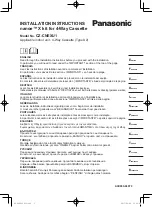
12
13
NOTE: In order to access the sealed system it will be necessary to install Schrader
type fittings to the process tubes on the discharge and suction of the compressor.
Proper recovery refrigerant procedures need to be adhered to as outlined in EPA
Regulations. THIS SHOULD ONLY BE ATTEMPTED BY QUALIFIED SERVICE
PERSONNEL.
Undercharged Refrigerant Systems
An undercharged system will result in poor performance (low
pressures, etc.) in both the heating and cooling cycle.
Whenever you service a unit with an undercharge of
refrigerant, always suspect a leak. The leak must be
repaired before charging the unit.
To check for an undercharged system, turn the unit on, allow
the compressor to run long enough to establish working
pressures in the system (15 to 20 minutes).
During the cooling cycle you can listen carefully at the exit
of the metering device into the evaporator; an intermittent
hissing and gurgling sound indicates a low refrigerant
charge. Intermittent frosting and thawing of the evaporator
is another indication of a low charge, however, frosting
and thawing can also be caused by insufficient air over
the evaporator.
Checks for an undercharged system can be made at the
compressor . If the compressor seems quieter than normal,
it is an indication of a low refrigerant charge. A check of the
amperage drawn by the compressor motor should show a
lower reading. (Check the Unit Specification.) After the unit
has run 10 to 15 minutes, check the gauge pressures.
Gauges connected to system with an undercharge will
have low head pressures and substantially low suction
pressures.














































